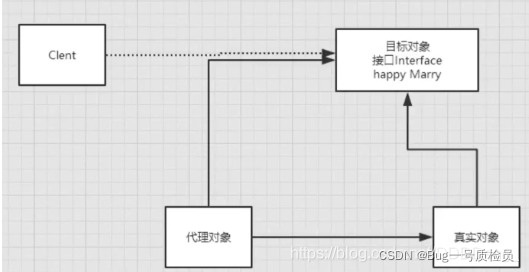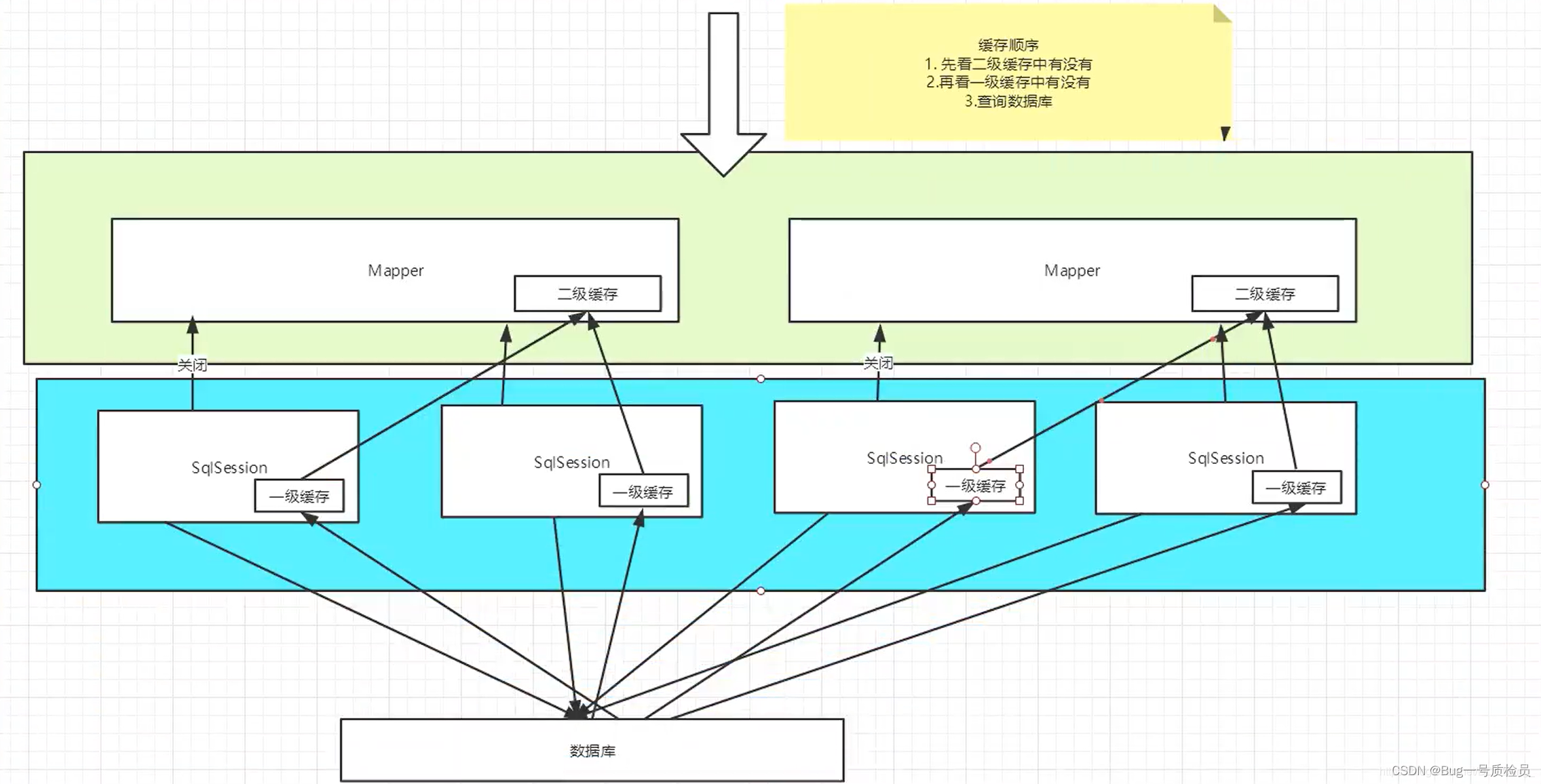文章目录
- MyBatis详细执行流程
- 使用注解开发
- 面向接口开发
- 使用注解开发
- 复杂查询
- 多对一问题
- 测试环境搭建
- 按照查询嵌套处理(子查询、嵌套查询)
- 按照结果查询(联表查询、联合查询)
- 一对多问题
- 环境搭建
- 按照结果查询(联表查询、联合查询)
- 按照查询嵌套处理(子查询、嵌套查询)
- 小结
- 动态SQL
- 搭建环境
- 动态SQL的常用语句
- IF判断语句
- choose-when-otherwise(单选语句)
- For-each遍历语句
- SQL片段
- Mybatis缓存
- 缓存简介
- MyBatis缓存
- 一级缓存
- 二级缓存
- 缓存原理
- 自定义缓存 Ehcache
(续上篇)
MyBatis详细执行流程

使用注解开发
简单的sql用注解,复杂的用xml
面向接口开发
- 大家之前都学过面向对象编程,也学习过接口,但在真正的开发中,很多时候我们会选择面向对象接口编程;
- 根本原因:解耦,可拓展,提高复用,分层开发中,上层不用管具体的实现,大角度遵守共同的标准,使的开发变得容易,规范性更好;
- 在一个面向对象的而系统中,系统的各种功能是由许许多多的不同对象协作完成的。这种情况下,各个对象内部是如何实现自己的,对系统设计人员来讲就不那么重要了;
- 而各个对象之间的协作关系设计的关键。小到不同类之间的通信,大到各个模块之间的交互,在系统设计之初都是要着重考虑的,这也是系统设计的主要工作内容。面向接口编程就是指按照这种思想来编程。
关于接口的理解
- 接口更深层次的理解,应是定义(规范,约束)与实现(名实分离的原则)的分离
- 接口本身反应了系统设计人员对系统的抽象管理。
- 接口应有两类
1.第一类是对一个个体的抽象,他可对应为一个抽象体(abstract class)
2.第二类是对一个个体某一方面的抽象,即形成一个抽象面(interface) - 一个个体可能有多个抽象面,抽象体与抽象面是有区别的
三个面向区别
- 面向对象是指,我们考虑问题时,以对象为单位,考虑它的属性及方法
- 面向过程是指,我们考虑问题时,以一个具体的流程(事务过程)为单位,考虑它的实现。
- 接口设计与非接口设计是针对复用技术而言的,与面向对象(过程)不是一个问题,更多的体现就是对系统整体的构架。
使用注解开发
注解在接口上实现:
public interface UserMapper {@Select("select * from user")List<User> getUsers();//方法存在多个参数,所有的参数必须加@Param@Select("select * from user where id = #{id}")User getUserById(@Param("id") int id);// #{}里面的是实体类属性名@Insert("insert into user (id, name, pwd) values (#{id},#{name},#{password})")int addUser(User user);@Update("update user set name=#{name}, pwd=#{password} where id=#{id}")int updateUser(User user);@Delete("delete from user where id=#{id}")int deleteUser(@Param("id") int id);}
在核心配置文件中绑定接口:
<mappers><mapper class="com.cheng.dao.UserMapper"/></mappers>
对于增删改操作,如果要用注解实现,需要在MybatisUtil中改为自动提交事务:
public static SqlSession getSqlSession(){return sqlSessionFactory.openSession(true);}
测试:
public class UserMapperTest {@Testpublic void selectTest() {SqlSession sqlSession = MybatisUtils.getSqlSession();UserMapper mapper = sqlSession.getMapper(UserMapper.class);List<User> users = mapper.getUsers();for (User user : users) {System.out.println(user);}sqlSession.close();}@Testpublic void getByIdTest(){SqlSession sqlSession = MybatisUtils.getSqlSession();UserMapper mapper = sqlSession.getMapper(UserMapper.class);User user = mapper.getUserById(1);System.out.println(user);sqlSession.close();}@Testpublic void addTest(){SqlSession sqlSession = MybatisUtils.getSqlSession();UserMapper mapper = sqlSession.getMapper(UserMapper.class);mapper.addUser(new User(7, "asddfh","123"));sqlSession.close();}@Testpublic void updateTest(){SqlSession sqlSession = MybatisUtils.getSqlSession();UserMapper mapper = sqlSession.getMapper(UserMapper.class);mapper.updateUser(new User(9, "zxczxc","123"));sqlSession.close();}@Testpublic void deleteTest(){SqlSession sqlSession = MybatisUtils.getSqlSession();UserMapper mapper = sqlSession.getMapper(UserMapper.class);mapper.deleteUser(9);sqlSession.close();}}
本质:反射机制实现
底层:动态代理

关于@Param( )注解
- 基本类型的参数或者String类型,需要加上
- 引用类型不需要加
- 如果只有一个基本类型的话,可以忽略,但是建议大家都加上
- 我们在SQL中引用的就是我们这里的@Param()中设定的属性名
#{} 和 ${}
- #{}是预编译处理,${}是字符串替换。
- Mybatis 在处理#{}时,会将 sql 中的#{}替换为?号,调用 PreparedStatement 的 set 方法来赋值;
- Mybatis 在处理${}时,就是把${}替换成变量的值。
- 使用#{}可以有效的防止 SQL 注入,提高系统安全性。
复杂查询
property:映射到列结果的字段或属性。
column:数据库中的列名,或者是列的别名。
- 多个学生关联一个老师(多对一)
- 集合(一对多)
多对一问题
例:多个学生对应一个老师
多对一业务例子:
查询所有学生的信息,以及对应老师的信息
测试环境搭建
- 导入lombok(可选),建表
CREATE TABLE `teacher` (`id` INT(10) NOT NULL,`name` VARCHAR(30) DEFAULT NULL,PRIMARY KEY (`id`)
) ENGINE=INNODB DEFAULT CHARSET=utf8INSERT INTO teacher(`id`, `name`) VALUES (1, '秦老师');CREATE TABLE `student` (`id` INT(10) NOT NULL,`name` VARCHAR(30) DEFAULT NULL,`tid` INT(10) DEFAULT NULL,PRIMARY KEY (`id`),KEY `fktid` (`tid`),CONSTRAINT `fktid` FOREIGN KEY (`tid`) REFERENCES `teacher` (`id`)
) ENGINE=INNODB DEFAULT CHARSET=utf8
INSERT INTO `student` (`id`, `name`, `tid`) VALUES (1, '小明', 1);
INSERT INTO `student` (`id`, `name`, `tid`) VALUES (2, '小红', 1);
INSERT INTO `student` (`id`, `name`, `tid`) VALUES (3, '小张', 1);
INSERT INTO `student` (`id`, `name`, `tid`) VALUES (4, '小李', 1);
INSERT INTO `student` (`id`, `name`, `tid`) VALUES (5, '小王', 1);
- 新建实体类
@Data
@AllArgsConstructor
@NoArgsConstructor
public class Teacher {private int id;private String name;
}
@Data
@AllArgsConstructor
@NoArgsConstructor
public class Student {private int id;private String name;//学生需要关联一个老师private Teacher teacher;
}
- 建立Mapper接口
public interface StudentMapper {List<Student> getStudent();
}
public interface TeacherMapper {@Select("select * from teacher where id = #{tid}")Teacher getTeacher(@Param("tid") int id);
}
- 建立Mapper.xml文件
<?xml version="1.0" encoding="UTF8" ?>
<!DOCTYPE mapperPUBLIC "-//mybatis.org//DTD Config 3.0//EN""http://mybatis.org/dtd/mybatis-3-mapper.dtd"><mapper namespace="com.cheng.dao.StudentMapper"></mapper>
<?xml version="1.0" encoding="UTF8" ?>
<!DOCTYPE mapperPUBLIC "-//mybatis.org//DTD Config 3.0//EN""http://mybatis.org/dtd/mybatis-3-mapper.dtd"><mapper namespace="com.cheng.dao.TeacherMapper"></mapper>
- 在核心配置文件中绑定注册我们的Mapper接口或者文件
<mappers><mapper resource="com/cheng/dao/TeacherMapper.xml"></mapper><mapper resource="com/cheng/dao/StudentMapper.xml"></mapper>
</mappers>
- 测试
public class MyTest {@Testpublic void test1(){SqlSession sqlSession = MybatisUtils.getSqlSession();TeacherMapper mapper = sqlSession.getMapper(TeacherMapper.class);Teacher teacher = mapper.getTeacher(1);System.out.println(teacher);sqlSession.close();}
}
按照查询嵌套处理(子查询、嵌套查询)
StudentMapper.xml
<mapper namespace="com.cheng.dao.StudentMapper"><!--思路:1. 查询所有的学生信息2. 根据查询出来的学生的tid寻找特定的老师 (子查询)--><select id="getStudent" resultMap="StudentTeacher">select * from student</select><resultMap id="StudentTeacher" type="com.cheng.pojo.Student"><result property="id" column="id"></result><result property="name" column="name"/><!--复杂的属性,我们需要单独出来对象:association集合:collection--><!--javaType用于描述property的类型--><association property="teacher" column="tid" javaType="com.cheng.pojo.Teacher" select="getTeacher"></association></resultMap><select id="getTeacher" resultType="com.cheng.pojo.Teacher">select * from teacher where id = #{id};</select>
</mapper>
测试
@Testpublic void test2(){SqlSession sqlSession = MybatisUtils.getSqlSession();StudentMapper mapper = sqlSession.getMapper(StudentMapper.class);List<Student> student = mapper.getStudent();for (Student stuList : student) {System.out.println(stuList);}sqlSession.close();}
输出
按照结果查询(联表查询、联合查询)
<select id="getStudent2" resultMap="StudentTeacher2">select s.id sid,s.name sname,t.name tnamefrom student s ,teacher twhere s.tid = t.id</select><resultMap id="StudentTeacher2" type="com.cheng.pojo.Student"><result property="id" column="sid"/><result property="name" column="sname"/><association property="teacher" javaType="com.cheng.pojo.Teacher"><result property="name" column="tname"/></association></resultMap>回顾Mysql 多对一查询方式:
- 子查询
- 联表查询
一对多问题
例:一个老师有多个学生。对于老师而言为一对多。
一对多业务例子:
获取指定老师下的所有学生及老师的信息
环境搭建
- 重建实体类
@Data
@AllArgsConstructor
@NoArgsConstructor
public class Teacher {private int id;private String name;// 一个老师有多个学生private List<Student> student;
}
@Data
@AllArgsConstructor
@NoArgsConstructor
public class Student {private int id;private String name;// 学生关联一个老师private int tid;
}
- Mapper接口
public interface TeacherMapper {// 获取指定老师下的所有学生及老师的信息Teacher getTeacher(@Param("tid") int id);
}
按照结果查询(联表查询、联合查询)
TeacherMapper.xml
<mapper namespace="com.cheng.dao.TeacherMapper"><select id="getTeacher" resultMap="TeacherStudent">select s.id sid, s.name sname, t.name tname, t.id tidfrom student s, teacher twhere s.tid = t.id and t.id = #{tid};</select><resultMap id="TeacherStudent" type="com.cheng.pojo.Teacher"><result property="id" column="tid"/><result property="name" column="tname"/><!--复杂的属性单独处理 javaType为指定属性的类型但对于集合中的泛型信息,我们用oftype获取--><collection property="students" ofType="com.cheng.pojo.Student"><!--注意!!这里的collection的property的名称要和Teacher实体类的students属性名一致。ofType就是描述的是泛型里面的类型,因为要遍历List--><result property="id" column="sid"/><result property="name" column="sname"/><result property="tid" column="tid"/></collection></resultMap>
</mapper>
测试
public class MyTest {@Testpublic void test1(){SqlSession sqlSession = MybatisUtils.getSqlSession();TeacherMapper mapper = sqlSession.getMapper(TeacherMapper.class);Teacher teacher = mapper.getTeacher(1);System.out.println(teacher);sqlSession.close();}
}
按照查询嵌套处理(子查询、嵌套查询)
(不推荐,较难理解)
Mapper.xml
<select id="getTeacher2" resultMap="TeacherStudent2">select * from teacher where id = #{tid}</select><resultMap id="TeacherStudent2" type="com.cheng.pojo.Teacher"><collection property="students" column="id" ofType="com.cheng.pojo.Student"select="getStudentByTeacherId"></collection><!--column="id"指的是将Teacher的id传给子查询--></resultMap><select id="getStudentByTeacherId" resultType="com.cheng.pojo.Student">select * from student where tid = #{tid}</select>
个人理解:
property=“students” column="id"这个结果集映射是指,执行完前面的SQL语句后,要将结果映射出Teacher类实体(sql执行完得到的数据赋给实体类对象),
但是Teacher类的List<Student> students属性无法跟数据库的teacher表的字段有映射关系(teacher表只有id和name俩字段,且都跟同名属性一一对应了),所以需要通过子查询赋予List<Student> students值,所以就要将这个属性property="students"暂时跟老师的id映射起来,传递给select=“getStudentByTeacherId”,
子查询getStudentByTeacherId得到Student类,将其赋给Teacher实体类的List<Student> students属性。
小结
- 关联 - association 多对一
- 集合 - collection 一对多
- javaType & ofType
JavaType用来指定实体中属性类型
ofType映射到list中的类型,泛型中的约束类型
注意点:
- 保证sql可读性,尽量保证通俗易懂
- 注意字段问题
- 如果问题不好排查错误,使用日志
面试高频:
- Mysql引擎
- InnoDB底层原理
- 索引
- 索引优化
动态SQL
什么是动态SQL:动态SQL就是根据不同的条件生成不同的SQL语句
所谓的动态SQL,本质上还是SQL语句,只是我们可以在SQL层面,去执行一个逻辑代码
动态 SQL 是 MyBatis 的强大特性之一。如果你使用过 JDBC 或其它类似的框架,你应该能理解根据不同条件拼接 SQL 语句有多痛苦,例如拼接时要确保不能忘记添加必要的空格,还要注意去掉列表最后一个列名的逗号。利用动态 SQL,可以彻底摆脱这种痛苦。
搭建环境
- 建表
create table `blog`(`id` varchar(80) not null comment '博客id',`title` varchar(100) not null comment '博客标题',`author` varchar(30) not null comment '博客作者',`create_time` datetime not null comment '创建时间',`views` int(30) not null comment '浏览量',PRIMARY KEY (`id`))ENGINE=InnoDB DEFAULT CHARSET=utf8
- 创建Maven项目,导包
- 创建实体类
import lombok.Data;
import java.util.Date;@Data
public class Blog {private String id;private String title;private String author;private Date createTime;private int views;
}
- Mapper接口
public interface BlogMapper {int addBlog(Blog blog);
}
- Mapper.xml
<?xml version="1.0" encoding="UTF-8" ?>
<!DOCTYPE mapperPUBLIC "-//mybatis.org//DTD Config 3.0//EN""http://mybatis.org/dtd/mybatis-3-mapper.dtd"><mapper namespace="com.cheng.dao.BlogMapper"><insert id="addBlog" parameterType="blog">insert into blog(id,title,author,create_time,views)values (#{id},#{title},#{author},#{createTime},#{views});</insert>
</mapper>
-
核心配置文件写好Mapper.xml映射
-
另外,因为实体类属性名和数据库表字段名不一致,核心配置文件开启驼峰命名和经典数据库字段命名规则自动映射
<!--是否开启驼峰命名和经典数据库字段命名规则映射--><setting name="mapUnderscoreToCamelCase" value="true"/>
- 为了Blog的ID各不相同,编写一个生成随机ID的工具类
public class IdUtils {public static String getId() {return UUID.randomUUID().toString().replaceAll("-", "");}
}
- 添加数据
public class MyTest {@Testpublic void test() {SqlSession sqlSession = MybatisUtils.getSqlSession();BlogMapper mapper = sqlSession.getMapper(BlogMapper.class);Blog blog = new Blog();blog.setId(IdUtils.getId());blog.setTitle("Mybatis");blog.setAuthor("BUG质检员");blog.setCreateTime(new Date());blog.setViews(9999);mapper.addBlog(blog);blog.setId(IdUtils.getId());blog.setTitle("Java");mapper.addBlog(blog);blog.setId(IdUtils.getId());blog.setTitle("Spring");mapper.addBlog(blog);blog.setId(IdUtils.getId());blog.setTitle("微服务");mapper.addBlog(blog);// 记得设置自动提交事务sqlSession.close();}
}
动态SQL的常用语句
IF判断语句
- 接口
// 查询博客List<Blog> queryBlogIf(Map map);
- Mapper.xml
<!--使用where标签可以在当只查一个筛选条件时智能去掉and或or-->
<select id="queryBlogIf" parameterType="map" resultType="com.cheng.pojo.Blog">select * from blog<where><if test="title != null">and title = #{title}</if><if test="author != null">and author = #{author}</if></where></select>
- 测试
@Testpublic void queryBlogIfTest() {SqlSession sqlSession = MybatisUtils.getSqlSession();BlogMapper blogMapper = sqlSession.getMapper(BlogMapper.class);Map map = new HashMap();map.put("title", "java");List<Blog> list = blogMapper.queryBlogIf(map);for (Blog blog : list) {System.out.println(blog);}sqlSession.close();}输出

choose-when-otherwise(单选语句)
类似Java中的switch
前面的满足就不管后面满不满足了,尽管后面的也满足,只会输出最前面满足的情况
<!--提供了什么就按照什么来查找,啥都没提供就返回所有符合条件的--><select id="queryBlogChoose" parameterType="map" resultType="com.cheng.pojo.Blog">select * from blog<where><choose><when test="title != null">title = #{title}</when><when test="author != null">and author = #{author}</when><otherwise>and views = #{views}</otherwise></choose></where></select>
@Testpublic void queryBlogChooseTest() {SqlSession sqlSession = MybatisUtils.getSqlSession();BlogMapper blogMapper = sqlSession.getMapper(BlogMapper.class);Map map = new HashMap();map.put("title", "java");map.put("views", "9999");List<Blog> list = blogMapper.queryBlogChoose(map);for (Blog blog : list) {System.out.println(blog);}sqlSession.close();}

可见即使后面views很多都满足值9999的条件的结果,但是不会输出
trim标签(连接SQL语句的前后缀标签。包括where标签和set标签,也可自定义标签)
where标签上面例子可以参考
set标签例子:
// 更新博客int updateBlog(Map map);
<!--set标签类似where标签,都是最终跟SQL语句连起来的,跟where标签类似,会智能去掉逗号--><update id="updateBlog" parameterType="map">update blog<set><if test="title != null">title = #{title},</if><if test="author != null">author = #{author},</if></set>where id = #{id}</update>
@Testpublic void updateBlogTest() {SqlSession sqlSession = MybatisUtils.getSqlSession();BlogMapper mapper = sqlSession.getMapper(BlogMapper.class);Map map = new HashMap();map.put("title", "python");map.put("views", "1234");map.put("id","63caee93010b4f15ae3dbd676d73e7aa");mapper.updateBlog(map);sqlSession.close();}
自定义trim标签(了解即可,建议百度)
For-each遍历语句
例:遍历查询前三个id的博客(需要将前面例子的id的UUID改成1、2、3的id)
接口:
// 遍历查询List<Blog> queryBlogForeach(Map map);
Mapper.xml:
<!--select * from blog where (id=1 or id=2 or id=3)--><!--使用map存放一个集合,ids是map的键,集合是键的值,集合里面装有id(Integer包装类)--><!--ids是测试类传过来的,#{id}是遍历的--><select id="queryBlogForeach" parameterType="map" resultType="com.cheng.pojo.Blog">select * from blog<where><foreach collection="ids" item="id" open="(" close=")" separator="or">id=#{id}</foreach></where></select>
测试类:
@Testpublic void queryBlogForeachTest(){SqlSession sqlSession = MybatisUtils.getSqlSession();BlogMapper blogMapper = sqlSession.getMapper(BlogMapper.class);Map map = new HashMap();ArrayList<Integer> ids = new ArrayList<>();ids.add(1);ids.add(2);ids.add(3);map.put("ids",ids);// 要与xml中的<foreach collection的值同名List<Blog> list = blogMapper.queryBlogForeach(map);for (Blog blog : list) {System.out.println(blog);}sqlSession.close();}
小结:
动态SQL就是在拼接SQL语句,我们只要保证SQL的正确性,按照SQL的格式,去排列组合就可以了
一般先在MySQL中写出完整的SQL,再对应的去修改成我们的动态SQL实现通用即可
SQL片段
有时我们会有一些经常重复且相同的代码,经常写重复的代码很烦
- 使用SQL标签抽取公共部分
- 在使用的地方使用include标签(有点像前端页面导入header和footer)
拿上面的queryBlogIf举例:
<sql id="if-title-author"><if test="title != null">title = #{title}</if><if test="author != null">and author = #{author}</if></sql><select id="queryBlogIf" parameterType="map" resultType="com.cheng.pojo.Blog">select * from blog<where><include refid="if-title-author"></include></where></select>
注意:
- 最好基于单表来定义SQL片段
- sql标签里不要存在where标签
Mybatis缓存
- 查询需要连接数据库,耗资源
- 一次查询的结果,给他暂存一个可以直接取到的地方 --> 内存:缓存
我们再次查询的相同数据的时候,直接走缓存,不走数据库了,查询效率快很多
缓存简介
什么是缓存[Cache]?
- 存在内存中的临时数据
- 用户经常查询的数据放在缓存(内存)中,用户去查询数据就不用从磁盘上(关系型数据库文件)查询,从缓存中查询,从而提高查询效率,解决了高并发系统的性能问题
为什么使用缓存?
- 减少和数据库的交互次数,减少系统开销,提高系统效率
什么样的数据可以使用缓存?
- 经常查询并且不经常改变的数据 ,可以使用缓存
- 不经常查询或者经常改变的数据,不建议使用缓存
MyBatis缓存
- MyBatis包含一个非常强大的查询缓存特性,它可以非常方便的定制和配置缓存,缓存可以极大的提高查询效率。
- MyBatis系统中默认定义了两级缓存:一级缓存和二级缓存
- 默认情况下,只有一级缓存开启(SqlSession级别的缓存,也称为本地缓存)
- 二级缓存需要手动开启和配置,他是基于namespace级别的缓存。
- 为了提高可扩展性,MyBatis定义了缓存接口Cache。我们可以通过实现Cache接口来定义二级缓存。
一级缓存
一级缓存也叫本地缓存:SqlSession
- 与数据库同一次会话期间查询到的数据会放在本地缓存中
- 以后如果需要获取相同的数据,直接从缓存中拿,没必要再去查询数据库
测试步骤:
-
开启日志
-
测试在一个Session中查询两次记录
-
查看日志输出
缓存失效的情况:
- 查询不同的东西
- 增删改操作,可能会改变原来的数据,所以必定会刷新缓存
- 查询不同的Mapper.xml
- 手动清理缓存
sqlSession.clearCache();
二级缓存
二级缓存也叫全局缓存,一级缓存作用域太低了,所以诞生了二级缓存
基于namespace级别的缓存,一个名称空间,对应一个二级缓存
工作机制
- 一个会话查询一条数据,这个数据就会被放在当前会话的一级缓存中
- 如果会话关闭了,这个会员对应的一级缓存就没了;但是我们想要的是,会话关闭了,一级缓存中的数据被保存到二级缓存中
- 新的会话查询信息,就可以从二级缓存中获取内容
- 不同的mapper查询出的数据会放在自己对应的缓存(map)中
测试步骤:
- 在核心配置文件中开启全局缓存
<!--显式地开启全局缓存-->
<setting name="cacheEnabled" value="true"/>
- 在Mapper.xml中使用缓存
这样使用默认配置
<!--在当前Mapper.xml中使用二级缓存-->
<cache/>
这样使用自定义配置
<!--在当前Mapper.xml中使用二级缓存-->
<cacheeviction="FIFO"flushInterval="60000"size="512"readOnly="true"/>
也可以单独设置某个查询是否使用缓存
<select id="getUserById" resultType="..." parameterType=".." useCache="true">
缓存策略
- LRU – 最近最少使用的:移除最长时间不被使用的对象。
- FIFO – 先进先出:按对象进入缓存的顺序来移除它们。
- SOFT – 软引用:移除基于垃圾回收器状态和软引用规则的对象。
- WEAK – 弱引用:更积极地移除基于垃圾收集器状态和弱引用规则的对象
- 测试
问题:我们需要将实体类序列化,否则就会报错
public class User implements Serializable{...}
小结:
- 只要开启了二级缓存,在同一个Mapper下就有效
- 所有的数据都会放在一级缓存中
- 只有当前会话提交,或者关闭的时候,才会提交到二级缓存中
缓存原理

自定义缓存 Ehcache
Ehcache是一种广泛使用的开源Java分布式缓存。主要面向通用缓存
导入Maven
<dependency><groupId>org.mybatis.caches</groupId><artifactId>mybatis-ehcache</artifactId><version>1.2.1</version>
</dependency>
在Mapper.xml中配置自定义缓存,设置成使用第三方自定义缓存
<cache type="org.mybatis.caches.ehcache.EhcacheCache"/>
ehcache.xml
<?xml version="1.0" encoding="UTF-8"?>
<ehcache xmlns:xsi="http://www.w3.org/2001/XMLSchema-instance"xsi:noNamespaceSchemaLocation="http://ehcache.org/ehcache.xsd"updateCheck="false"><!--diskStore:为缓存路径,ehcache分为内存和磁盘两级,此属性定义磁盘的缓存位置。参数解释如下:user.home – 用户主目录user.dir – 用户当前工作目录java.io.tmpdir – 默认临时文件路径--><diskStore path="java.io.tmpdir/Tmp_EhCache"/><!--defaultCache:默认缓存策略,当ehcache找不到定义的缓存时,则使用这个缓存策略。只能定义一个。--><!--name:缓存名称。maxElementsInMemory:缓存最大数目maxElementsOnDisk:硬盘最大缓存个数。eternal:对象是否永久有效,一但设置了,timeout将不起作用。overflowToDisk:是否保存到磁盘,当系统宕机时timeToIdleSeconds:设置对象在失效前的允许闲置时间(单位:秒)。仅当eternal=false对象不是永久有效时使用,可选属性,默认值是0,也就是可闲置时间无穷大。timeToLiveSeconds:设置对象在失效前允许存活时间(单位:秒)。最大时间介于创建时间和失效时间之间。仅当eternal=false对象不是永久有效时使用,默认是0.,也就是对象存活时间无穷大。diskPersistent:是否缓存虚拟机重启期数据 Whether the disk store persists between restarts of the Virtual Machine. The default value is false.diskSpoolBufferSizeMB:这个参数设置DiskStore(磁盘缓存)的缓存区大小。默认是30MB。每个Cache都应该有自己的一个缓冲区。diskExpiryThreadIntervalSeconds:磁盘失效线程运行时间间隔,默认是120秒。memoryStoreEvictionPolicy:当达到maxElementsInMemory限制时,Ehcache将会根据指定的策略去清理内存。默认策略是LRU(最近最少使用)。你可以设置为FIFO(先进先出)或是LFU(较少使用)。clearOnFlush:内存数量最大时是否清除。memoryStoreEvictionPolicy:可选策略有:LRU(最近最少使用,默认策略)、FIFO(先进先出)、LFU(最少访问次数)。FIFO,first in first out,这个是大家最熟的,先进先出。LFU, Less Frequently Used,就是上面例子中使用的策略,直白一点就是讲一直以来最少被使用的。如上面所讲,缓存的元素有一个hit属性,hit值最小的将会被清出缓存。LRU,Least Recently Used,最近最少使用的,缓存的元素有一个时间戳,当缓存容量满了,而又需要腾出地方来缓存新的元素的时候,那么现有缓存元素中时间戳离当前时间最远的元素将被清出缓存。--><defaultCacheeternal="false"maxElementsInMemory="10000"overflowToDisk="false"diskPersistent="false"timeToIdleSeconds="1800"timeToLiveSeconds="259200"memoryStoreEvictionPolicy="LRU"/><cachename="cloud_user"eternal="false"maxElementsInMemory="5000"overflowToDisk="false"diskPersistent="false"timeToIdleSeconds="1800"timeToLiveSeconds="1800"memoryStoreEvictionPolicy="LRU"/></ehcache>
![[Leedcode][JAVA][第1014题][最佳观光组合][数组][暴力优化]](http://pic.xiahunao.cn/[Leedcode][JAVA][第1014题][最佳观光组合][数组][暴力优化])




![[剑指offer][JAVA]面试题第[27]题[二叉树的镜像][递归][栈]](http://pic.xiahunao.cn/[剑指offer][JAVA]面试题第[27]题[二叉树的镜像][递归][栈])




![[leetcode][JAVA]面试题第[1028]题[迭代]](http://pic.xiahunao.cn/[leetcode][JAVA]面试题第[1028]题[迭代])







![[Leedcode][JAVA][第125题][验证回文串][双指针][String]](http://pic.xiahunao.cn/[Leedcode][JAVA][第125题][验证回文串][双指针][String])